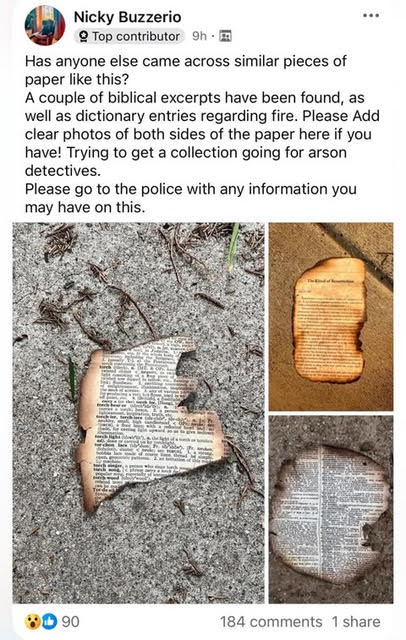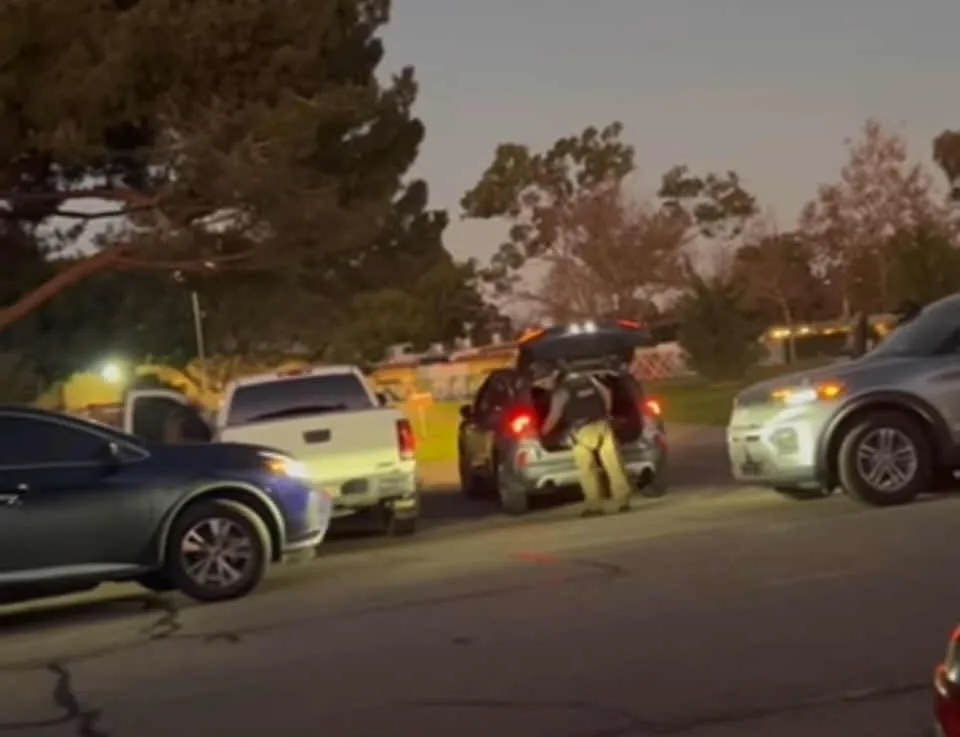On social media, Los Angeles residents have been posting apocalyptic-like photos of partially burnt pages of books, passages from the Quran, magazine ads, family photos, and even pornography that have landed in their backyards and on the properties where they live, amid the raging wildfires.
In some cases, people are finding the same partially burned pages from the same books in different parts of the city, sometimes more than a dozen miles away from the nearest wildfire.
Some people see this as a tragic example of how intense the unprecedented fires and winds have been over the past week. As of Tuesday morning, Los Angeles area fires have burned nearly 60 square miles of land, nearly the size of three Manhattans.
Ohers, meanwhile, see it as a glimmer of hope amongst the ashes and despair.
“This just landed in my sister’s Silverlake backyard. Zoom in. Read carefully,” writer and producer Liz Feldman wrote on Instagram, referring to a burnt piece of paper that contained the word “baraq,” the Hebrew word for “to restore, to repair.”
“A message from above,” Feldman said. “And if you know my family, you will notice a very special name. This brought us to tears. This incredible city will rebuild. Repair. And restore. LA, you have my heart and soul.”
And then there are those who believe that the artifacts landing on people’s properties are part of some larger conspiracy.
“This didn’t just happen to me,” influencer Meghan Rienks said in a video posted on her TikTok, which boasts more than 179,000 followers.
Rienks said she found a partially burnt, circular piece of paper in her yard depicting Donald Trump sitting with French President Emmanuel Macron at a table on one side, and a note written in Trump’s handwriting on the other side.
“It's so crazy, it’s made me almost a full blown conspiracy theorist,” she joked.
Rienks, who said she evacuated her house due to one of the fires, believes someone trespassed onto her property and placed the partially burnt photo “underneath a pot” in her yard. The influencer claimed that the piece of paper could have only been burned in a circle by a person with a lighter, citing a community note on the Elon Musk-owned social media platform X.
“This was intentionally done,” she said.
“I’m not saying I was specifically targeted,” Rienks clarified. “I don't think that at all. But I am saying this was not a random coincidence, because it’s going to be a lot of coincidences,” Rienks said before presenting a montage of screenshots of other people finding partially burnt pieces of paper.
Over the last several days, L.A. resident Ezra Woods has collected such photos from people, many of who, like Reinks, think that the book pages and documents that they came across were intentionally burned by a person or persons.
Others suggested that the burnt pages could be evidence that the fires were started by arsonists.
“These pages are burned in a way that they can still be read,” one person wrote. “I think they’re evidence and should be collected and submitted for arson investigation.”
“My friend is saying it’s an arsonist calling card perhaps,” another user claimed. “Which I’ve never heard of. But super freaky.”
People have also noticed eerie coincidences on the pages that they’ve found, such as references to “Ash Day” and dates that refer to recent days when the fires burned.
“Wild that it says Jan 9th,” a person pointed out to Woods about one of the discovered papers, a couple of days after January 9.
“Totally,” Woods responded.

Another resident found a charred page from ‘The Road,’ author Cormac McCarthy’s 2006 post-apocalyptic novel about a father and son’s journey across an ash-covered United States. The page contains the words “among the ashes.”
Robert Rowe, a former arson investigator with the Downey Fire Department, who has 27 years of experience determining the cause of fires, said he is not surprised that people are finding burnt pieces of paper and other debris on their properties.
“It’s not surprising that areas or buildings or maybe even churches, or different types of establishments that do have a lot of books, that when they burn and they begin to collapse, [the wind] is going to be blowing all of that material downwind for miles," the veteran fire investigator emphasized. “Miles and miles.”
In the Pacific Palisades, Altadena, and Pasadena, more than 12,000 structures (which include buildings, as well as cars, trucks, and RVs) have been damaged or destroyed, including the Theosophical Library Center on Lake Avenue in Altadena, along with the Pacific Palisades Public Library on Alma Real Drive.
And it’s not like this hasn’t happened before.
A partially burnt bible verse was similarly found in a person’s yard after the 2016 Great Smoky Mountain fires in Tennessee, according to reports from Knox News and CNN. And there were also reports of a resident in Chico finding a partially burnt piece of paper during the devastating 2018 Camp Fire in Paradise, California.
“I don’t think it’s unusual,” Rowe said.
After leaving the Downey Fire Department in 2007, Rowe started his own fire investigation firm. During his nearly three decade career, he has investigated thousands of fires from Alaska to New York, in addition to doing consulting work in the Middle East.
Rowe theorized that the hurricane force winds that the L.A. area has seen over the past week could rip out pages of books and then send those pieces of paper miles downwind.
“Whoever is downwind are going to wind up with pieces of paper, maybe burning embers, all kinds of debris,” he asserted.
In some cases, embers can even start new fires, he noted.
Daniel Swain, a prominent UCLA climate scientist focused on the impacts of extreme events, agrees that it’s not unusual to find debris in your yard during an urban wildfire.
“Although it certainly offers a dramatic visual, seeing partially burnt pages from books and newspapers fall from this sky is an all-to-familiar experience for anyone who has experienced a major fire that destroyed numerous structures,” he said.
Swain says that he has personally experienced this phenomenon multiple times, “and it is a decidedly eerie yet entirely explainable phenomenon.”
In his explanation, Swain notes that wildfires generate a lot of heat, which results “in upward vertical air motion immediately over the fire because the hot air is less dense than the cooler air above.”
This process is known as “convection.”
“During a very large and intense fire, as we unfortunately saw with both the Palisades and Eaton firestorms last week, debris within the fire's path can become entrained in the air within the fire's rapidly rising convection column,” Swain said.
There have been credible reports of flaming objects as large as small tree branches being lifted “as high as several thousand feet vertically during especially intense forest fires,” according to Swain. But more commonly, small, light-in-weight objects like leaves and twigs rise within the fire’s vertical plume.
Once the materials are in the air, they’re moved horizontally “as much as several miles” by winds, Swain says.
During the Eaton and Palisades fires, there were wind gusts of 80 or 90 mph, he notes.
“There is footage of debris as large as individual flaming palm fronds flying through the air as the Eaton Fire was spreading through Altadena, so it's fairly easy to imagine how smoldering pages from books and newspapers could easily behave similarly,” Swain said.
Rowe says he understands why people are alarmed.
“Right now everyone is emotionally charged,” he said. “Everyone wants to know why these fires started, everybody. And I think they’re expecting the investigators to come up with a cause, and they very well may. But it’s not an easy process, it’s a very complex process, and people get very, very impatient.”
Rowe encourages everyone to refer potential leads to the proper authorities. However, he noted that many leads are “dead ends” and investigators will have to look into all of them.
In the meantime, he asks that people without a background in fire investigation or climate science hold off on drawing conclusions.
“Before you try to draw a conclusion, number one, are you trained to investigate fires?” Rowe questioned. “And two, is it just an opinion without any scientific evidence?”
When investigating the cause of fires, investigators like Rowe develop a hypothesis and then go through the meticulous process of verifying their theory by studying wind patterns and other forensic evidence.
Sometimes they find a cause, other times they don’t.
“A lot of people will develop a hypothesis and it will be the truth [to them]… there has to be some kind of proof to back up what you’re saying,” Rowe argued.
Even after a thorough investigation, Rowe said we might not ever know exactly where the pages came from.
“The weirdest things happen with fires,” he said.
“I don't consider it to be a conspiracy theory,” he said. “I consider it to be an act of nature.”







